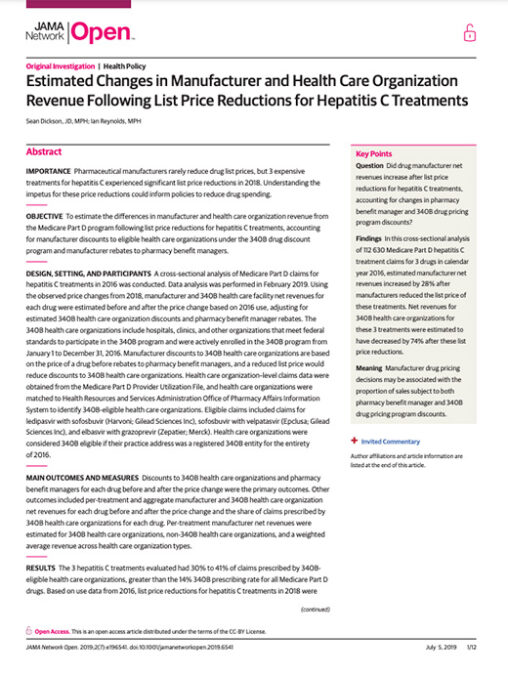Study in JAMA Network Open Examines Impact of Hepatitis Drug Price Reductions on Manufacturer and Health Care Organization Revenue
Abstract
Importance
Pharmaceutical manufacturers rarely reduce drug list prices, but 3 expensive treatments for hepatitis C experienced significant list price reductions in 2018. Understanding the impetus for these price reductions could inform policies to reduce drug spending.
Objective
To estimate the differences in manufacturer and health care organization revenue from the Medicare Part D program following list price reductions for hepatitis C treatments, accounting for manufacturer discounts to eligible health care organizations under the 340B drug discount program and manufacturer rebates to pharmacy benefit managers.
Design, Setting, and Participants
A cross-sectional analysis of Medicare Part D claims for hepatitis C treatments in 2016 was conducted. Data analysis was performed in February 2019. Using the observed price changes from 2018, manufacturer and 340B health care facility net revenues for each drug were estimated before and after the price change based on 2016 use, adjusting for estimated 340B health care organization discounts and pharmacy benefit manager rebates. The 340B health care organizations include hospitals, clinics, and other organizations that meet federal standards to participate in the 340B program and were actively enrolled in the 340B program from January 1 to December 31, 2016. Manufacturer discounts to 340B health care organizations are based on the price of a drug before rebates to pharmacy benefit managers, and a reduced list price would reduce discounts to 340B health care organizations. Health care organization–level claims data were obtained from the Medicare Part D Provider Utilization File, and health care organizations were matched to Health Resources and Services Administration Office of Pharmacy Affairs Information System to identify 340B-eligible health care organizations. Eligible claims included claims for ledipasvir with sofosbuvir (Harvoni; Gilead Sciences Inc), sofosbuvir with velpatasvir (Epclusa; Gilead Sciences Inc), and elbasvir with grazoprevir (Zepatier; Merck). Health care organizations were considered 340B eligible if their practice address was a registered 340B entity for the entirety of 2016.
Main Outcomes and Measures
Discounts to 340B health care organizations and pharmacy benefit managers for each drug before and after the price change were the primary outcomes. Other outcomes included per-treatment and aggregate manufacturer and 340B health care organization net revenues for each drug before and after the price change and the share of claims prescribed by 340B health care organizations for each drug. Per-treatment manufacturer net revenues were estimated for 340B health care organizations, non-340B health care organizations, and a weighted average revenue across health care organization types.
Results
The 3 hepatitis C treatments evaluated had 30% to 41% of claims prescribed by 340Beligible health care organizations, greater than the 14% 340B prescribing rate for all Medicare Part D drugs. Based on use data from 2016, list price reductions for hepatitis C treatments in 2018 were estimated to have increased aggregate manufacturer net revenues for 3 treatments by $181.9 million—a 28% increase. Aggregate 340B health care organization net revenues were estimated to have been $181.9 million lower—a 74% decrease.
Conclusions and Relevance
List price reductions for hepatitis C treatments may have increased drug manufacturer net revenues, owing in part to lower discounts provided under the 340B program and the high share of sales subject to those discounts. Policymakers should consider the role of 340B discounts when evaluating policies to reduce drug spending.


